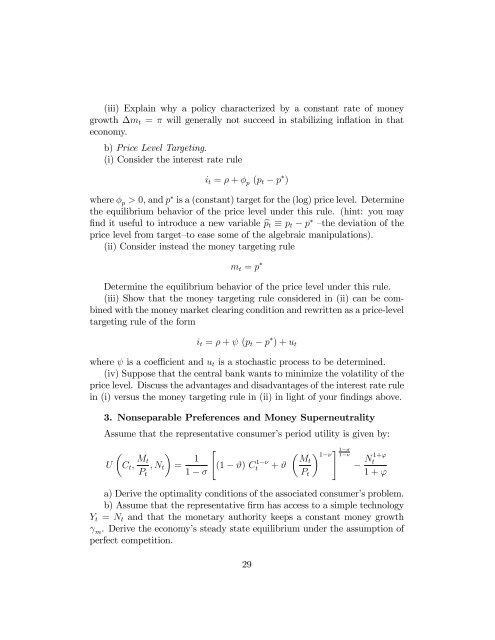Monetary Policy, Inflation, and the Business Cycle Chapter 2 A ...
Monetary Policy, Inflation, and the Business Cycle Chapter 2 A ...
Monetary Policy, Inflation, and the Business Cycle Chapter 2 A ...
Create successful ePaper yourself
Turn your PDF publications into a flip-book with our unique Google optimized e-Paper software.
(iii) Explain why a policy characterized by a constant rate of money<br />
growth m t = will generally not succeed in stabilizing in‡ation in that<br />
economy.<br />
b) Price Level Targeting.<br />
(i) Consider <strong>the</strong> interest rate rule<br />
i t = + p (p t p )<br />
where p > 0, <strong>and</strong> p is a (constant) target for <strong>the</strong> (log) price level. Determine<br />
<strong>the</strong> equilibrium behavior of <strong>the</strong> price level under this rule. (hint: you may<br />
…nd it useful to introduce a new variable bp t p t p –<strong>the</strong> deviation of <strong>the</strong><br />
price level from target–to ease some of <strong>the</strong> algebraic manipulations).<br />
(ii) Consider instead <strong>the</strong> money targeting rule<br />
m t = p <br />
Determine <strong>the</strong> equilibrium behavior of <strong>the</strong> price level under this rule.<br />
(iii) Show that <strong>the</strong> money targeting rule considered in (ii) can be combined<br />
with <strong>the</strong> money market clearing condition <strong>and</strong> rewritten as a price-level<br />
targeting rule of <strong>the</strong> form<br />
i t = + (p t<br />
p ) + u t<br />
where is a coe¢ cient <strong>and</strong> u t is a stochastic process to be determined.<br />
(iv) Suppose that <strong>the</strong> central bank wants to minimize <strong>the</strong> volatility of <strong>the</strong><br />
price level. Discuss <strong>the</strong> advantages <strong>and</strong> disadvantages of <strong>the</strong> interest rate rule<br />
in (i) versus <strong>the</strong> money targeting rule in (ii) in light of your …ndings above.<br />
3. Nonseparable Preferences <strong>and</strong> Money Superneutrality<br />
Assume that <strong>the</strong> representative consumer’s period utility is given by:<br />
U<br />
<br />
C t ; M "<br />
t<br />
; N t = 1 (1 #) Ct 1 + #<br />
P t 1 <br />
# 1 <br />
1 1 <br />
Mt<br />
P t<br />
N 1+'<br />
t<br />
1 + '<br />
a) Derive <strong>the</strong> optimality conditions of <strong>the</strong> associated consumer’s problem.<br />
b) Assume that <strong>the</strong> representative …rm has access to a simple technology<br />
Y t = N t <strong>and</strong> that <strong>the</strong> monetary authority keeps a constant money growth<br />
m . Derive <strong>the</strong> economy’s steady state equilibrium under <strong>the</strong> assumption of<br />
perfect competition.<br />
29
















